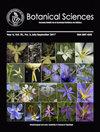Studies of plant hydraulics and water relations in Mexican environments: adaptation, physiology, and applications
IF 0.7
4区 生物学
Q3 PLANT SCIENCES
引用次数: 1
Abstract
Given the outstanding global progress of research on the hydraulic pathway in plants, and its important role as an indicator of plant mortality risk, we reviewed: (1) the adaptive basis of hydraulic traits and their importance for overall plant function; (2) the number of primary scientific articles on plant hydraulics that have been produced in Mexico in the last 40 years, (3) research related to specific environments in Mexico, and (4) the possible applications of plant hydraulics to natural resource management. Our systematic review included 83 articles. The number of publications per year steadily increased over time, reaching its maximum in 2021. Veracruz and Yucatán are the states where the majority of scientific articles on plant hydraulics have been produced, but for most states less than two publications on this subject appeared in ca. 40 years, and none was found for Oaxaca and Chiapas, the most biodiverse states. In plant hydraulics, the most studied biome in Mexico was the tropical dry forest, followed by crops; trees were the most studied growth-form, followed by herbaceous crops and epiphytes. We point to the need of enhancing research in the interface between plant hydraulic function and remote sensing, as well as developing applications in adaptive forest management and ecological restoration. We hope that this review may ignite a national collaborative effort to quantify critical traits that could inform the hydraulic functioning of Mexican ecosystems, particularly in the underrepresented and highly diverse states of Mexico.墨西哥环境中植物水力学和水关系的研究:适应、生理和应用
鉴于植物水力通路在全球范围内的研究进展及其作为植物死亡风险指标的重要作用,本文综述了:(1)水力特性的适应基础及其对植物整体功能的重要性;(2)在过去的40年里,墨西哥生产的关于植物水力学的主要科学文章的数量,(3)与墨西哥特定环境相关的研究,以及(4)植物水力学在自然资源管理中的可能应用。我们的系统综述包括83篇文章。随着时间的推移,每年的出版物数量稳步增长,在2021年达到最大值。韦拉克鲁斯州和Yucatán是大多数关于植物水力学的科学文章发表的州,但对于大多数州来说,在大约40年里,关于这一主题的出版物少于两篇,而瓦哈卡州和恰帕斯州则没有发现,这是生物多样性最多的州。在植物水力学方面,墨西哥研究最多的生物群系是热带干燥森林,其次是农作物;树木是研究最多的生长形式,其次是草本作物和附生植物。指出需要加强植物水力功能与遥感之间的接口研究,并在适应性森林管理和生态恢复中开发应用。我们希望这篇综述可以点燃全国合作的努力,量化可以为墨西哥生态系统水力功能提供信息的关键特征,特别是在墨西哥代表性不足和高度多样化的州。
本文章由计算机程序翻译,如有差异,请以英文原文为准。
求助全文
约1分钟内获得全文
求助全文
来源期刊

Botanical Sciences
Agricultural and Biological Sciences-Plant Science
CiteScore
1.90
自引率
21.40%
发文量
71
审稿时长
16 weeks
期刊介绍:
Botanical Sciences welcomes contributions that present original, previously unpublished results in Botany, including disciplines such as ecology and evolution, structure and function, systematics and taxonomy, in addition to other areas related to the study of plants. Research reviews are also accepted if they summarize recent advances in a subject, discipline, area, or developmental trend of botany; these should include an analytical, critical, and interpretative approach to a specific topic. Acceptance for reviews will be evaluated first by the Review Editor. Opinion Notes and Book Reviews are also published as long as a relevant contribution in the study of Botany is explained and supported.
 求助内容:
求助内容: 应助结果提醒方式:
应助结果提醒方式:


